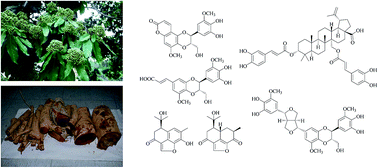Bioactive composition of Reevesia formosana root and stem with cytotoxic activity potential†
Abstract
Six new compounds including three lignanoids: reevesiacoumarin (1), reevesic acid (2), and reevesilignan (3), and three terpenoids: reevesiterpenol A (4), reevesiterpenol B (5), and 3α,27-di-O-trans-caffeoylbetulinic acid (6), along with 40 known compounds were isolated from the root and stem of Reevesia formosana (Sterculiaceae). The structures of 1–6 were determined by spectroscopic techniques. Bioassays for the cytotoxicities of MCF-7, NCI–H460, and HepG2 cancer cell lines led to finding three cardenolides: strophanthojavoside (31) and ascleposide (32) with IC50 < 1 μM and strophalloside (33) displayed selective cytotoxicity to NCI–H460 with IC50 0.62 ± 0.06 μM as well. 3α,27-Di-O-trans-caffeoylbetulinic acid (6) and secoisolariciresinol (13) also showed weak but selective cytotoxicity to NCI–H460 and HepG2 cancer cell lines, respectively.



 Please wait while we load your content...
Please wait while we load your content...